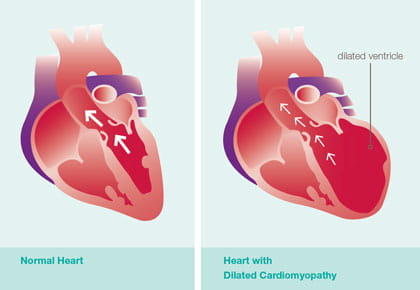The treatment for individuals with DCM is different for each person. Treatment is aimed at the cause of the heart failure if known. The primary goal is to improve cardiac function and prevent symptoms. Individuals with DCM need to be followed by a cardiologist on a regular basis. Medications are used to treat symptoms, reverse heart damage and to prevent further damage to the heart muscle. Medications such as beta-blockers and ACE inhibitors will be used in most cases. Other medications may be prescribed to manage symptoms or to prevent abnormal heart rhythms.
Lifestyle changes are recommended for some individuals. Exercise is generally important, however, individuals with DCM may experience fatigue and shortness of breath with exercise. It’s important for these individuals to limit their activity if they become tired, dizzy or have difficulty breathing. In some cases, exercise is not recommended and participation in competitive sports may be discouraged.
Some people with DCM are at increased risk for sudden cardiac arrest, which results from a sudden loss of heart function caused by a fast heart rhythm called ventricular tachycardia. Unless emergency treatments are initiated immediately, including CPR and defibrillation, sudden cardiac death can occur. For individuals at risk for sudden cardiac arrest, an implantable cardioverter-defibrillator (ICD) may be recommended. In some patients with DCM, a pacemaker (cardiac resynchronization therapy) may be combined with the ICD. Mechanical pacing from different areas of the heart may improve the heart’s ability to supply blood to the body.
If cardiac function continues to worsen despite medications, a mechanical device may be necessary to help the heart pump and supply blood to the body. The device that would be used for young children is called the Berlin heart device. For older children and adults there are multiple devices that could be surgically placed to provide cardiac support. In some cases, if the condition is severe, a heart transplant may be considered.




